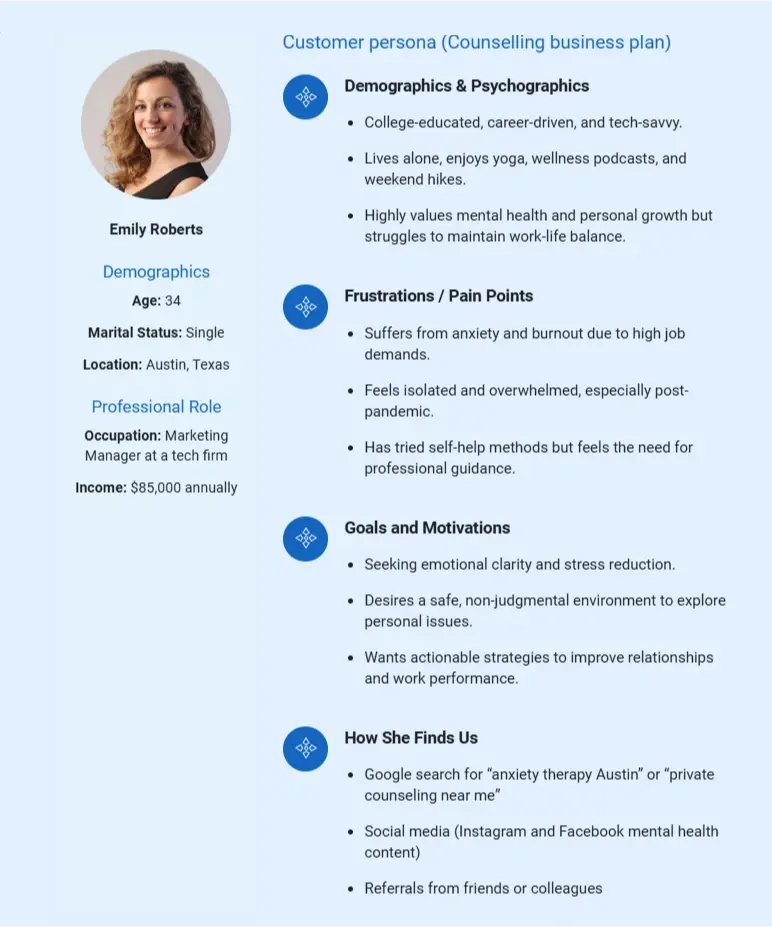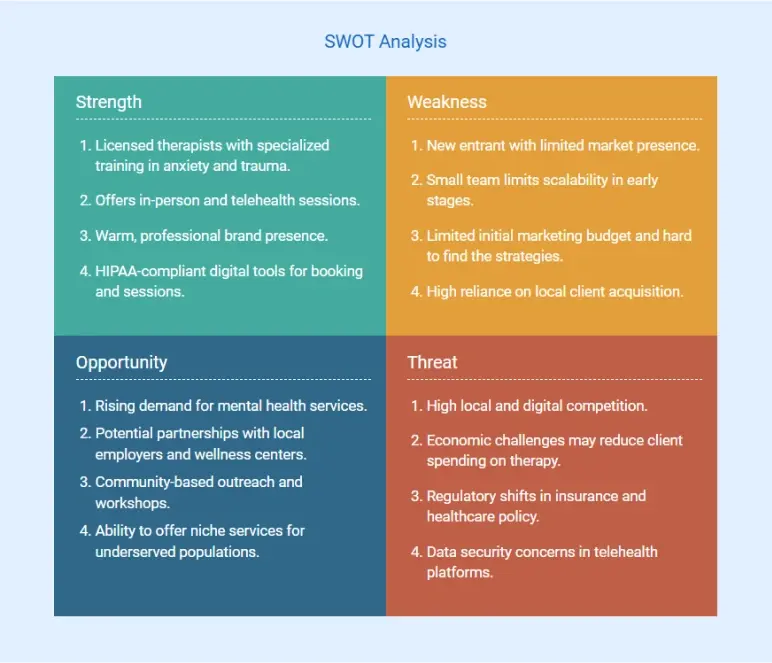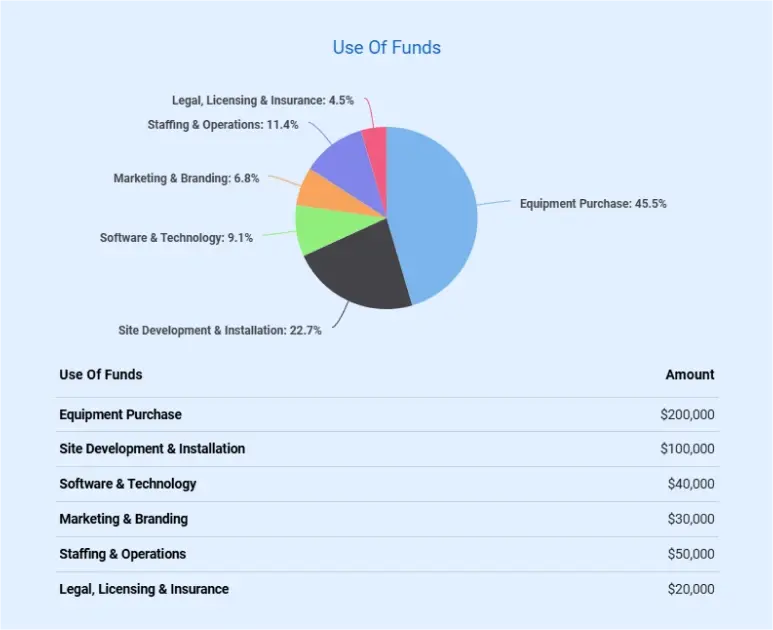Starting a counseling practice is exciting… until the paperwork, planning, and money talk kick in.
How do you figure out your rates, find the right clients, and convince a bank or investor you’re worth backing?
That’s why we put together a simple business private practice business plan template, so you’re not stuck staring at a blank page.
The template helps you to understand what to include, how to organize it, and what lenders or partners actually want to see.
Grab it and let’s walk through building a plan that works for you.
How to write a counseling private practice business plan?
A good business plan explains your vision, your market, and your plan to succeed. For counselors, it means showing both your expertise and your ability to run a business.
Here’s how to shape each section of your private counseling practice:
1. Executive Summary
The executive summary is a quick pitch to your reader. It gives an overview of what your practice is about, why it exists, and what you aim to achieve. Most people write it last (summarise key points from other sections), but it should appear first in your business plan.
Start by stating your practice’s name and where you’re located. Mention who you serve, and what kind of therapy you offer. If you have a unique philosophy, treatment approach, or background, include that too, but in plain, non-clinical language.
Here’s what this might look like structurally:
- Business name + location
- Who you serve + the problem you’re solving
- Type of services + how you deliver them
- 1–2 lines about your background or motivation
- Quick list of business goals or outcomes you’re aiming for
- Financial snapshot
Let’s have a look at a sample (Serenity Path Counselling Services) executive summary:
Keep it real, especially when listing your goals. Don’t write “become a national leader in XYZ care” if your actual goal is to earn $8K/month and run a local solo practice. That’s totally valid, and way more relatable.
Say goodbye to boring templates
Build your business plan faster and easier with AI
Plans starting from $14/month

2. Company Description
This section is where you explain what your counseling practice actually is, not just the idea, but how it functions as a business.
Start with your legal structure and business type. Are you operating as a solo practitioner under an LLC? A group practice? Is it a partnership?
Then mention your mission and vision of the company; what your practice is about, and who it is meant to serve. Make it brief and very exact. Some generic sentiments, such as the line “Our mission is to deliver high-quality mental health care to everyone”, should be avoided.
Instead, write something closer to:
“Our mission is to make trauma-informed therapy accessible to Black women navigating high-functioning anxiety in urban settings.”
Follow that with a quick overview of what stage your business is in. Are you just starting out, renting a shared office, and seeing 5 clients a week?
You can also include details like:
- Your practice’s niche or specialty (e.g., couples therapy, LGBTQ+ youth, trauma recovery)
- Therapy modalities you offer (e.g., EMDR, DBT, somatic therapy)
- Whether you operate in-person, virtual, or both
- Your current capacity (number of clients/week) and short-term growth plan
If you plan to grow into a group practice later, it’s okay to briefly mention that, but don’t write like it’s already happening if you’re still a solo practitioner. Investors and readers value honesty more than hype.
3. Market Analysis
The market analysis section is all about understanding the counseling industry, your target market, and the local competition. It’s your chance to prove there’s real demand for your services and that you know how to stand out.
Check out the steps to draft this section:
Step 1: Understand the industry
Start with a quick snapshot of the counseling and mental health industry, ideally with credible stats from trusted sources like APA or NIMH.
Example: According to Mental Health America (MHA), nearly 1 in 5 U.S. adults live with a mental illness, yet many lack access to consistent therapy.
If you offer a niche service (e.g., trauma therapy, couples counseling, teen counseling), look for stats that show growth or demand for that specialty.
Step 2: Define your target audience
Get specific; “people who need therapy” is too broad. Think about age, location, income range, cultural background, and life stage.
A few buyer profiles would look like:
| Persona name | Age range | Needs/challenges | Preferred delivery | Price sensitivity |
|---|---|---|---|---|
| Stressed professional | 28–45 | Burnout, work–life imbalance | Online weekday evenings | Medium |
| Newly married couple | 25–35 | Communication issues | In-person sessions | Medium–High |
| College student | 18–24 | Anxiety, adjustment issues | Virtual sessions | High (prefers sliding scale) |
Look at this detailed buyer persona created in Upmetrics:

Step 3: Identify market trends
List the trends that affect demand for your services. For example:
- Growing demand for telehealth and hybrid counseling options
- Increased awareness of mental health in schools and workplaces
- Employer wellness programs covering counseling sessions
- Clients seeking culturally sensitive or specialized therapy approaches
Step 4: Competitor analysis
Look at 3–5 similar competitors in your area. Analyze the competitors and try to answer the following questions:
- What services do they offer?
- What’s their pricing structure?
- Do they focus on a specific niche?
- What do clients say in their reviews (Google, Yelp)?
- Where are the gaps you can fill?
To make this section more engaging, include:
- A SWOT analysis chart for your practice (Strengths, Weaknesses, Opportunities, Threats)
- Or even a PESTLE analysis if you want to show wider market factors (Political, Economic, Social, Technological, Legal, Environmental)
You can easily create either in Upmetrics. Look at the SWOT analysis generated in Upmetrics:

4. Services & Pricing
This section tells people what you offer, how you deliver it, and what you charge. It should be clear enough that someone could skim it and instantly understand your services and whether they fit their needs.
Start by listing your main services. Use plain, non-clinical language so it’s easy to follow, even for someone who’s never been in therapy before. If you use a specific approach (e.g., CBT, EMDR), you can mention it, but don’t let jargon take over.
Include details like:
- Who the service is for (target client)
- How you deliver it (in-person, virtual, or both)
- Typical session length
- Price or price range
It’s also a good idea to mention whether you offer package pricing, sliding-scale fees, or accept insurance, and if so, which providers.
Here’s what that might look like structurally:
| Service name | Who is it for | Delivery method | Session length | Price |
|---|---|---|---|---|
| Individual therapy | Adults dealing with anxiety, depression, or life changes | In-person or online | 50 mins | $100–$150 |
| Couples counseling | Partners working through relationship challenges | In-person | 60 minutes | $130–$180 |
| Group therapy | Small groups focused on a shared challenge (e.g., grief, parenting) | In-person | 90 minutes | $40–$60 per person |
| Workplace workshop | Teams seeking stress management or communication skills | On-site or virtual | 1–2 hours | $300–$500 |
It is a good practice to research 3–5 local practices to make sure your rates are competitive while still covering costs.
5. Marketing & Sales Strategy
This section outlines how you plan to attract new clients and turn inquiries into booked sessions. For a private counseling practice, your marketing strategy should focus on visibility, trust, and making it easy for people to take the first step toward working with you.
When planning this section, combine both marketing and sales actions, think of it as the full path from “people finding you” to “people becoming clients.”
The most important aspects to cover here are the following:
- Online presence – Create a professional, mobile-friendly website with your services, bio, and easy booking links.
- Local SEO – Set up and maintain your Google Business Profile so you appear in “therapist near me” searches.
- Professional directories – List your profile on sites like Psychology Today, GoodTherapy, or TherapyDen.
- Referral partnerships – Network with physicians, schools, HR departments, yoga studios, and community organizations to receive referrals on a continual basis.
- Educational outreach – Free workshops, webinars, or Q&A sessions on the subject of stress management or healthy communication.
- Social media presence – Post practical, non-clinical mental health tips to build trust and familiarity.
- Consultation offers – Provide a short, free consultation (phone or video) to lower the barrier for first-time clients.
- Follow-up system – After inquiries or consultations, send a friendly follow-up with next steps and scheduling options.
- Client retention – Keep current clients engaged with progress check-ins, reminders for follow-up sessions, or seasonal offers.
In short, your marketing and sales strategy should make it easy for people to find you, understand what you offer, and feel confident about booking their first session.
6. Operations Plan
Your operations plan is where you show how your counseling practice works daily. It’s not just about what you offer, but exactly how you deliver it in a reliable, organized way.
Location and setup
Start with where and how you’ll operate. Are you renting an office, working from a shared therapy space, or offering only virtual sessions?
Mention accessibility for clients (parking, public transport, wheelchair access) and whether your space is private and soundproof. If you’re running online sessions, name the telehealth platform you use and confirm it’s HIPAA-compliant.
Service delivery
Walk the reader through a typical client journey. How do they find you, book an appointment, and attend their first session? Do you send forms before their first visit? Mention how you handle follow-ups or ongoing scheduling.
Scheduling and tools
Describe your booking process, whether a practice management software, an integrated practice like SimplePractice, TherapyNotes, or a calendar app. How do you manage your client appointments, rescheduling, or cancellations?
Staffing and support
If you have a team, describe who does what, from therapists to administrative help. Even in a solo practice, mention outsourced roles, like bookkeeping or marketing support.
Quality and growth plans
Lastly, explain how you maintain quality over time, client feedback, peer consultation, or supervision. If you plan to expand (add therapists, open another location, or add group services), outline how you’d make that transition smoothly.
7. Management & Staffing
This section shows who leads your practice and why they’re qualified to make it succeed. Share details about ownership, leadership experience, and the support team that keeps operations running smoothly.
Even if you’re working solo, use this space to highlight your skills and any part-time or contract help you rely on.
If you’re unsure what to include, cover:
- Who owns and runs the practice, and their main responsibilities
- Relevant experience and credentials (degrees, licenses, certifications)
- Support staff or contractors, such as admin, billing, or sales & marketing
- Specialties (if you have multiple practitioners)
- Advisors or supervisors you work with
- An org chart for a clear view of roles
- Future hiring plans
Example for a solo practice:
“Calm Path Counseling is owned and operated by Jane Doe, a licensed professional counselor with 8 years of experience in trauma-informed care. Jane manages all client sessions, business administration, and marketing with the help of a part-time virtual assistant who handles scheduling and billing.”
Be honest. If you plan to hire in the future, say so, but don’t write as if it’s already in place
8. Financial Plan
Your financial plan shows how much money you need to start or run your practice, what you’ll spend it on, and how you expect to make it back.
Even if you’re not looking for funding, this section is useful for readers in understanding whether your business will be sustainable.
Startup costs
List the one-time expenses you’ll have before you start seeing clients. For example:
| Item | Estimated Cost |
|---|---|
| Office deposit & setup | $2,500–$5,000 |
| Furniture & décor | $1,000–$3,000 |
| Therapy tools & materials | $300–$1,000 |
| Computer & equipment | $1,000–$2,000 |
| Practice management software | $40–$80/month |
| Licensing & insurance | $500–$1,000 |
| Marketing & website | $500–$2,000 |
| Miscellaneous | $200–$500 |
Ongoing monthly expenses
These are the costs you’ll pay every month to keep the practice running.
| Expense | Estimated Cost |
|---|---|
| Office rent | $800–$1,500 |
| Utilities & internet | $150–$300 |
| Practice management software | $40–$80 |
| Insurance | $40–$100 |
| Marketing | $100–$300 |
| Professional development | $50–$200 |
| Miscellaneous | $50–$100 |
Revenue projections
Estimate how many sessions you expect to hold each week, at what average fee, and calculate monthly and yearly totals.
| Sessions per Week | Avg. Fee per Session | Monthly Revenue | Annual Revenue |
|---|---|---|---|
| 15 | $120 | $7,200 | $86,400 |
| 20 | $120 | $9,600 | $115,200 |
| 25 | $120 | $12,000 | $144,000 |
Here are a few tips for writing this section:
- Charge your session fee based on local market rates and your experience level.
- Include a conservative estimate and an optimistic one; this helps with planning for slow months.
- If you’re applying for funding, clearly state how much you need and exactly what it will be used for.
- Use charts or graphs (like a pie chart for a startup cost breakdown) to make numbers easy to understand.
9. Funding request
If you are seeking funding to start or grow your counseling practice, this is where you clearly explain how much you’re asking for and what you’ll do with it.
Begin by presenting how much you are asking in total. Next, you make a breakdown of it so that the lender can see where each penny shall go.
A simple structure you can follow:
- Amount requested (mention the amount you are seeking funding)
- Purpose of funds (break the total into categories)
- Funding source and terms (bank loan, grant, investor, or other source)
- Payback plan (if applicable)
Let’s look at an example:
Business name: Serene Path Counseling Services
Amount requested: $150,000
Purpose of funding:
Serene Path Counseling Services is seeking $150,000 in funding to support the launch and initial operations of our private counseling practice located in Austin, Texas. The funds will be utilized to cover startup costs, operational expenses for the first 12 months, and marketing initiatives necessary to attract and retain clients.
Breakdown of funding use:

Funding type:
We are open to either a traditional business loan or angel investment. If debt funding is pursued, we are prepared to negotiate terms that ensure timely repayment over a 5-year period at a competitive interest rate.
10. Appendix
The appendix is optional, but it’s a great place to include extra information that supports your plan without cluttering the main sections.
What to include:
- Copies of licenses, certifications, or professional memberships
- Sample client intake forms and consents
- Marketing material (flyer, brochures, screenshot of social media)
- Testimonials or reviews from past clients (if applicable)
- Resumes or bios for you and any staff members
- Detailed financial projections or spreadsheets
- Industry research or local market statistics
- Snapshots of your office/therapy area
- Policies (cancellation, privacy, sliding-scale fee policy)
Get your free private practice plan template
Putting your ideas into a clear business plan can feel like a challenge. To make it easier, we’ve put together a free private practice business plan template (PDF).
It’s drafted with counselling practice in mind, with prompts, examples, and space to outline your services, pricing, marketing ideas, and financial projections. Even if you’re applying for a loan, looking for referral partners, or simply want a structured growth plan, this template will help you get it all down in one place.
The Quickest Way to turn a Business Idea into a Business Plan
Fill-in-the-blanks and automatic financials make it easy.
Summary
By following the steps in this guide, you now have a structure for writing a business plan that works in the real world. It’s a living document you can update as your practice grows and your goals evolve.
If you’d like to save time and end up with a polished, professional plan without starting from scratch, Upmetrics can make that happen.
Upmetrics helps you write each section with guided prompts, build in accurate financial forecasts, and create visuals like SWOT charts and service tables, all in one organized, shareable format.
You know what goes into a plan, now make it happen with the right tool!




